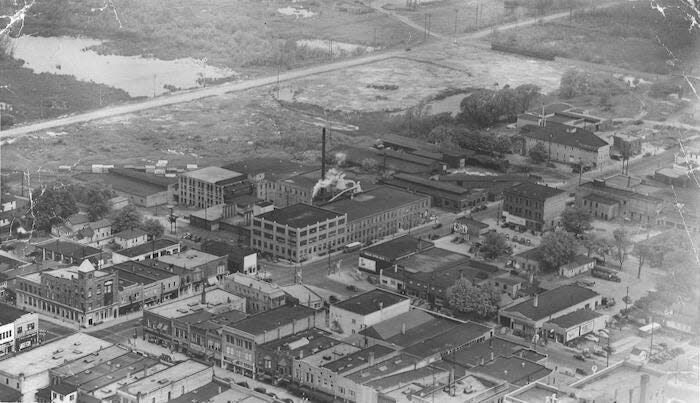Steve VanderVeen: Holland was once home to the women behind Lady Esther
Louis Padnos was an entrepreneur with a big heart.
In 1912-1913, when he heard his brother, Harry, had gone bankrupt in California trying to sell cosmetics to the movie industry, he convinced him to move his family to Holland. Before he left for military service in World War I, Louis also recruited his nephew to run his store.
More:The inspiring tale of Louis Padnos
More:Jacob Van Putten and Cornelis Ver Schure
But that didn't go as well as he'd hoped — being from the city and not familiar with animal skins, his nephew overpaid.
When Louis returned from the service, he fell in love with Helen Kantor, daughter of Rabbi David Kantor of Grand Rapids. Helen and Louis married. In 1920, they welcomed their first son, Seymour, and, in 1922, their second son, Stuart.
Louis’ business was also growing; he purchased a Ford car for the family and a Ford truck for the business, and moved the scrapyard to 190 E. Eighth St. — where the post office is located today. When Louis fell ill, Helen ran the business and the family for a year.
In 1932, Louis purchased the Ottawa Furniture Company, formerly Werkman, property at Fourth Street and River Avenue in a bank auction. There, he collected scrap paper and cardboard and sold them to the paper mills in Otsego and Kalamazoo. In 1938, he bought land west of the Holland Furniture Company, located on River Avenue and Seventh Street, to expand his operation.

For recreation — when not on the road, at work, or with his family — Louis played cards with Chief Blom’s men at the firehouse and brought cake, cookies and donuts.
He also helped his relatives.
Louis’ brother Harry married Ida Cohen in 1910. Ida’s family had immigrated to the United States from Poland. Her father, Aaron, came to America in 1892; she and her mother and siblings — Esther, Abraham (Otto), Sadie (Syma) and Simon — came to Chicago in 1889, where the family reunited.
After Harry and Ida married, they moved to California. After Harry’s bankruptcy, with Louis’ encouragement, they moved to Holland.
Harry and Ida, as well as Otto and Simon, lived at 83 W. 15th St. Otto opened his own business, the French Cloak Shop, at 26 E. Eighth St. and Simon clerked for Louis. Harry wanted his own store, so, with Louis’ backing, he opened a retail clothing business at 188 River Ave.
At first, things went well for Harry. In 1914, he reported in the national Boot and Shoe Recorder that the Harry Padnos Shoe and Clothing Store, a cash and bargain store, had doubled shoe capacity by repainting and redecorating an adjacent storeroom.
But by 1915, Harry was bankrupt and offering to settle his debts for 25 cents on the dollar. A clothing supplier sued him for misrepresenting his financial situation and the court agreed, resulting in a 19-month prison sentence for Harry.
When Harry returned from prison, he and Ida and the Cohens moved back to Chicago. But Ida’s relatives didn't leave empty-handed, to Holland’s economic loss.
While the Cohens were in Holland, the Cohen sisters — Ida, Esther and Syma — started making cosmetics in the back of Harry’s store and selling them door-to-door. Their first product was a facial cream, which they branded Lady Esther, after one of the Cohen sisters and the biblical queen.
They filed a trademark in 1913. Then, they traveled to New York City and signed a contract with Woolworths, the national chain. They traveled to Woolworth stores to teach staff how to sell the product and customers how to wear it.
Subscribe:Learn more about our latest subscription offers!
In Chicago, the Cohens continued working on their business. When Harry and Ida and Esther and Simon and their spouses moved to San Francisco, Otto and Syma stayed behind and built a factory near Evanston.

This time, the cosmetics business flourished. Its leading product was the Lady Esther “Four-Purpose Cream.” The brand also extended into facial, rouge and talcum powder. The Cohens incorporated as the Lady Esther Company in 1922. It lasted into the 1950s. People can still purchase Lady Esther brand products today.
Information from this article comes from Robert Swierenga’s "Holland, Michigan," Collecting Vintage Compacts, Hope College Digital Commons, a long-ago conversation with Seymour Padnos and a recent conversations with Mitch Padnos.
— Community Columnist Steve VanderVeen is a resident of Holland. Contact him through start-upacademeinc.com.
This article originally appeared on The Holland Sentinel: Holland History: Holland was once home to the women behind Lady Esther
